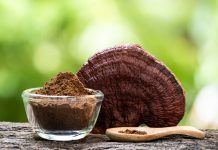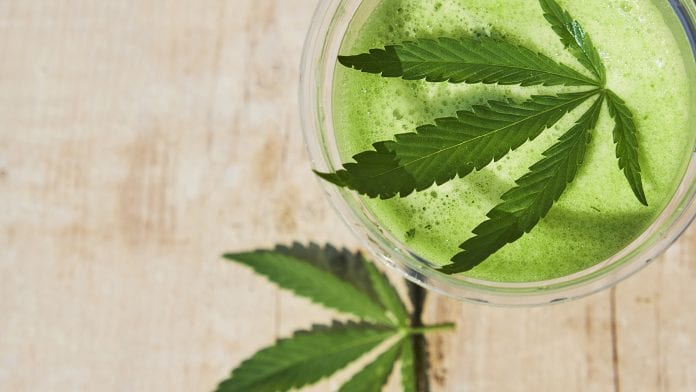
By adding nanoemulsion systems to its line of hemp and cannabis processing equipment, Root Sciences is (yet again) changing the industry’s approach to producing cannabis infused beverages.
In 2016, Root Sciences revolutionised the way cannabis-infused edibles were manufactured by launching German manufacturer VTA into the hemp and cannabis distillation space.
With the utilisation of VTA’s short-path wiped-film molecular distillation technology, Root Sciences established industry leading post-extraction processes to produce the purest form of cannabinoid distillate used in the formulation of edibles.
Did you know that we are partnered with Root Sciences? Click here to find out more.
Technological advances for an expanding market
Since 2016, the cannabis industry has seen steady growth. With marijuana legalisation expanding and the demand for hemp and cannabis products surging, the market for marijuana edibles and beverages has grown significantly.
The global cannabis market was reported to be worth approximately $10.60bn in 2018 and is projected to reach $97.35bn by 2026.1 As a result of the overall growth of the cannabis industry, the selection of cannabis-infused foods and beverages available for purchase across the globe is now larger than ever. According to Fortune Business Insights, the global cannabis beverage market size was worth $173.76m in 2018 and is projected to reach $2.05bn by 2026.2
With a view to the impending rise in global demand for cannabis beverages, Root Sciences joined forces with GEA, one of the largest global technology suppliers for food and beverage processing, in December of 2019. The two companies have partnered to bring the next generation of cannabinoid post-processing technology to market, virtually changing the entire cannabis beverage manufacturing industry.
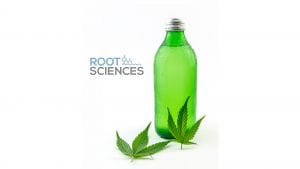
Defining cannabinoid nanoemulsions
An article published by the US National Library of Medicine3 defines nanoemulsion as a ‘fine oil/water or water/oil dispersion stabilised by an interfacial film of surfactant molecule having droplet size range 20–600nm’.
When applied to cannabinoid use, cannabis and hemp nanoemulsion-based beverages boast many advantages over traditionally manufactured edibles. Recent studies show that innovative products created with nanoemulsions take effect more quickly than traditional infused edibles and deliver a more consistent and enjoyable experience for consumers.
A much cleaner taste is also reported, due to the proprietary encapsulation and micronisation technologies at the heart of nanoemulsification, which vastly increase the bioavailability of the active ingredients: cannabinoids.
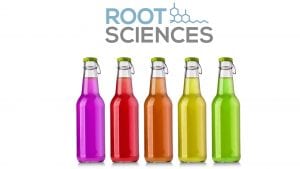
Find out more about the global nanoemulsion market.
Enhanced bioavailability
Bioavailability, in this application, is the measure of how much of the ingested THC or CBD is absorbed into the bloodstream and thus to what degree it elicits an effect on the consumer. Depending on the route of ingestion, this can be affected by a number of factors. For example, smoking flower, eating an edible, or drinking a nanoemulsion-based beverage will result in different effects on the consumer.
In one study, by investigating the bioavailability of a traditional edible (in the form of a 20mg THC chocolate chip cookie), scientists found that the absorption of THC from traditional edibles can be as low as 6%4 – so throughout the entire experience, the consumer of the cookie only experienced the effects of roughly 1.2mg of THC. This is a common but inefficient reality of edibles historically manufactured within the cannabis and hemp industry.
By contrast, a different study looking at the absorption of cannabinoids from a CBD nanoemulsion showed a total bioavailability of over 90%.5 In this case, if the subject consumed a 20mg THC beverage, the consumer would experience the effects of approximately 18mg of the total THC in the beverage. Obviously, this is a substantial improvement.
Research into the bioavailability of THC and CBD in nanoemulsions is ongoing, and early results appear quite promising. According to these studies, the bioavailability in nanoemulsions trumps what has historically been available through consumption of traditional edibles. The benefits of nanoemulsion-based beverages extend beyond improved bioavailability, as they are also absorbed by the body faster and more reliably.
Improved absorption rates
Due to the time delay of their psychoactive effects, it is no secret that traditional cannabis edibles can be problematic, especially for first time consumers. For example, an unseasoned consumer may not feel any effects an hour or more after consuming their first edible and may then make the decision to consume a second edible in an to attempt to get the correct dosage to achieve their desired effect. In this case, the consumer unknowingly consumes a total dose that is too high for the consumer’s tolerance level, causing an overall unpleasant experience with the product. The rate of absorption (or time delay) associated with traditionally manufactured edibles has been a concern, primarily due to the poor absorption of THC or CBD.
A major advantage of nanoemulsion-based beverages is the greatly increased rate of absorption. In a study looking at a CBD nanoemulsion, a maximum blood concentration was reached three times faster versus a non-nanoemulsified control.5 Traditional edibles can take as long as 8 hours to reach the maximum effect,4 whereas nanoemulsions can reach near-maximum levels in as little as one hour.5 This means that it takes less time to feel the onset of the edible and that the user has a cleaner, more predictable and enjoyable experience. Because the absorption rate and bioavailability of nanoemulsions are so much higher than with conventional edibles, a significantly smaller dose of cannabinoids is required in nanoemulsified edibles to achieve a similar effect, which is beneficial to both manufacturers and consumers.
Nanoemulsion stability benefits distribution channels
One of the major concerns manufacturers of edible commodities face is the challenge of distributing the product in a time sensitive manner before the product spoils or reaches its ‘best by’ date. Poor formulations can result in an unstable product with a brief shelf life, complicating product distribution and resulting in potential headaches for retailers having to manage expired products. Emulsion technologies have been used in the wider non-cannabis beverage industry for decades; and modern techniques enable the creation of nanoemulsions with typical shelf lives of greater than one year.
Many factors influence the stability of an emulsion, from matching the densities of the dispersed and continuous phases to optimising the surfactant system in order to minimise Ostwald ripening, flocculation, and coalescence of droplets.
The typical complexities of formulation have made it historically difficult for edibles manufacturers to break into the cannabis beverage sector. With its line of nanoemulsion technology, Root Sciences is helping to take the guesswork out of formulation for manufacturers. Backed by proven technology, Root Sciences has built a reputation of reliable, repeatable results through the use of its equipment and knowledge.
Consistency has been the cornerstone of Root Sciences’ widespread success in the extraction and distillation industries; and the company seeks to bring the same level of quality and support to its post-processing clientele with the GEA nanoemulsion technology.
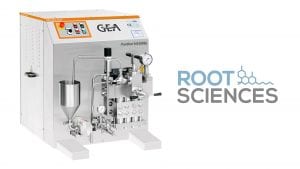
Manufacturing nanoemulsions
Cannabinoid beverage emulsions are composed of three phases:
- The dispersed phase;
- The continuous phase; and
- The interface between the dispersed and continuous phases.
The dispersed phase is composed of THC or CBD dissolved in a carrier oil such as MCT. Most commonly, a THC or CBD distillate or isolate is used, with the best distillates produced by the same short-path wiped-film molecular distillation systems Root Sciences brought to the cannabis industry in 2016, in partnership with VTA.
The continuous phase is made up of filtered water with stabilisers and additional ingredients, such as pH modifiers or preservatives. To help stabilise an emulsion, surface-active substances (called surfactants or emulsifiers) are added. The surfactants help to prevent the coalescence, or merging, of oil droplets, ensuring stability over time. As the oil is forced into tiny droplets, they are stabilised by the surfactants, forming the interface between the continuous and dispersed phases, and reducing the interfacial tension between the oil and water.
The production of cannabis nanoemulsions is a simple process and can be broken down into three simple steps. First, a coarse emulsion with large droplet sizes is created by mixing the ingredients together with a quickly rotating mixing device called a high shear mixer. These reliable, cheap devices spin at speeds as fast as 10,000rpm and force the oil to form droplets that are around 1/500 of a millimetre in diameter.
Second, the coarse emulsion is then fed into a GEA High-Pressure Homogeniser and recirculated a few times. The High-Pressure Homogeniser uses the efficient application of high-pressure energy to force the emulsion through a specifically engineered homogenising valve under high-shear conditions – at pressures as high as 30,000psi. The extreme shear forces produce droplets as small as 1/10,000 of a millimetre – or less than 1/1,000 the size of a human hair.
Finally, the nanoemulsion is then sterilised, either through heat pasteurisation or sterile filtration through a 0.22 micron filter, ensuring the nanoemulsion is free of any bacteria, viruses, or other microorganisms. The resulting stable nanoemulsion can be added to the beverage, which is then bottled and ready for distribution.
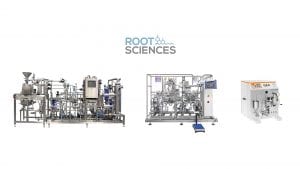
About GEA
GEA has been at the forefront of the design, construction, and use of High-Pressure Homogenisers for decades. Used in multiple industries, including the beverage and pharmaceutical industries, GEA is a world recognised brand in homogenisation. Their reliable, easy to service systems are fully CIP capable and GMP compliant, ensuring worry-free operation. GEA’s line of High-Pressure Homogenisers come in a wide range of capacities, from smaller operations requiring tabletop solutions, to the most demanding operations requiring flow rates as high as 5,000 litres per hour.
About Root Sciences
Root Sciences originally made a name for itself in 2016 when it revolutionised cannabis distillation technology with short-path wiped-film systems. By partnering with GEA, Root Sciences continues to innovate with its latest release: cannabinoid nanoemulsification technology.
In addition to its line of nanoemulsion technology systems, Root Sciences also provides a full range of large scale, German engineered cold ethanol extraction and continuous feed short-path wiped-film molecular distillation equipment.
Root Sciences’ high quality cryo-ethanol systems for cannabis crude oil extraction are manufactured by DEVEX of Germany. DEVEX is the leader in bio-extraction technology and represents vast experience with other commercial and industrial plant equipment for the food, pharmaceutical, and chemical industries. The CryoEXS is an all-in-one extraction system, capable of selectively and efficiently extracting hemp or cannabis at scales from 550kg per day to 5,500kg per day and beyond.
Root Sciences has also partnered with VTA, a German manufacturer of high-quality cannabis molecular distillation equipment. VTA specialises in short-path wiped-film distillation plants at laboratory, pilot, and industrial scale, in a wide variety of industries; and has been in business for over 25 years.
As the global leader in the distribution of equipment and support services for processing facilities in the cannabis and hemp industries, Root Sciences represents premium extraction, distillation, and now, nanoemulsification technologies. With GMP, UL, and CE compliant equipment available, Root Sciences delivers reliable end-to-end solutions, enabling processing companies to quickly become a dominant force in their market.
References
- https://www.fortunebusinessinsights.com/industry-reports/cannabis-marijuana-market-100219
- https://www.fortunebusinessinsights.com/industry-reports/cannabis-beverages-market-100738
- https://www.ncbi.nlm.nih.gov/pmc/articles/PMC4362737/
- https://ascpt.onlinelibrary.wiley.com/doi/abs/10.1038/clpt.1980.181
- https://www.karger.com/Article/Abstract/497361
Lauren Hitt
Director of Marketing
Root Sciences
+1 206 452 1130
marketing@rootsciences.com
This article will appear in the second issue of Medical Cannabis Network which is out in April. Click here to get your free subscription today.


